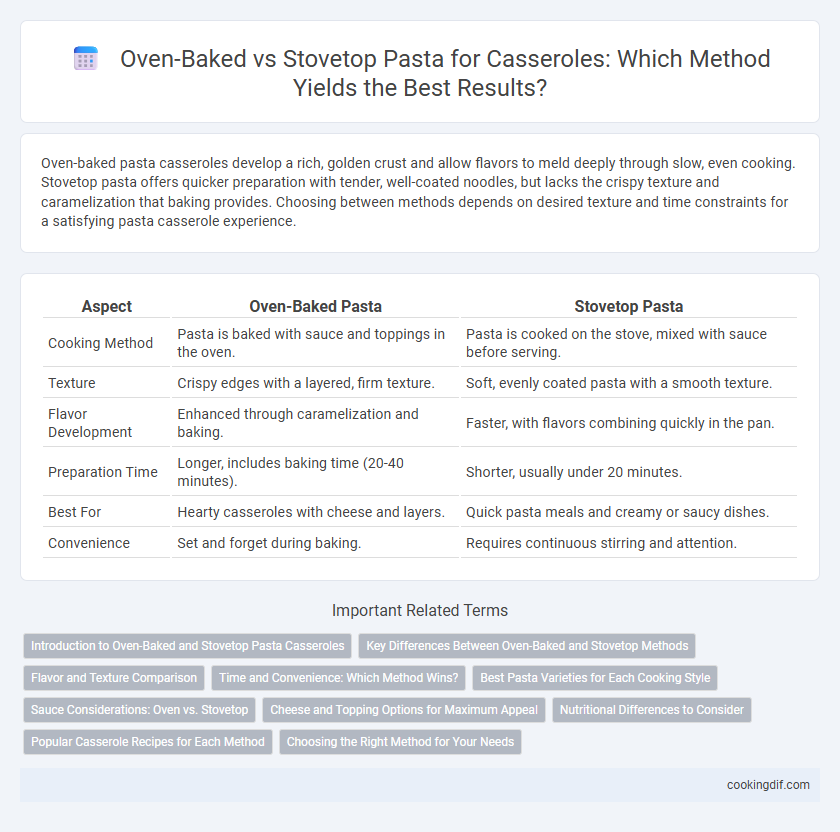Oven-baked pasta casseroles develop a rich, golden crust and allow flavors to meld deeply through slow, even cooking. Stovetop pasta offers quicker preparation with tender, well-coated noodles, but lacks the crispy texture and caramelization that baking provides. Choosing between methods depends on desired texture and time constraints for a satisfying pasta casserole experience.
Table of Comparison
| Aspect | Oven-Baked Pasta | Stovetop Pasta |
|---|---|---|
| Cooking Method | Pasta is baked with sauce and toppings in the oven. | Pasta is cooked on the stove, mixed with sauce before serving. |
| Texture | Crispy edges with a layered, firm texture. | Soft, evenly coated pasta with a smooth texture. |
| Flavor Development | Enhanced through caramelization and baking. | Faster, with flavors combining quickly in the pan. |
| Preparation Time | Longer, includes baking time (20-40 minutes). | Shorter, usually under 20 minutes. |
| Best For | Hearty casseroles with cheese and layers. | Quick pasta meals and creamy or saucy dishes. |
| Convenience | Set and forget during baking. | Requires continuous stirring and attention. |
Introduction to Oven-Baked and Stovetop Pasta Casseroles
Oven-baked pasta casseroles offer a crispy, golden top layer and evenly melded flavors, utilizing consistent heat to develop a rich, comforting texture ideal for hearty dishes like lasagna or baked ziti. Stovetop pasta casseroles provide quicker preparation with the ability to maintain more distinct pasta texture and incorporate fresh ingredients swiftly, perfect for creamy or saucy recipes such as mac and cheese or skillet pasta. Understanding these cooking methods helps optimize texture, flavor infusion, and convenience in pasta casserole dishes.
Key Differences Between Oven-Baked and Stovetop Methods
Oven-baked pasta casseroles develop a golden, crispy top layer due to direct heat exposure, enhancing texture and flavor complexity, while stovetop pasta maintains a softer consistency and faster cooking time. Oven baking allows ingredients to meld gradually, intensifying the sauce and cheese integration, whereas stovetop methods provide more control over moisture levels, preventing dryness. Nutrient retention differs slightly, with stovetop cooking preserving heat-sensitive vitamins better due to shorter exposure times compared to the prolonged heat of oven baking.
Flavor and Texture Comparison
Oven-baked pasta casseroles develop a rich, caramelized crust with a deeper, roasted flavor profile and a firm, slightly chewy texture from prolonged heat exposure. Stovetop pasta casseroles offer a softer, creamier texture and more uniform flavor infusion as ingredients meld gently during cooking. Flavor complexity and textural contrast are heightened in oven-baked dishes, while stovetop methods prioritize smoothness and tenderness.
Time and Convenience: Which Method Wins?
Oven-baked pasta casseroles typically require 30 to 45 minutes of cooking time, offering hands-off convenience while allowing flavors to meld and toppings to crisp. Stovetop pasta methods take about 10 to 15 minutes for boiling and combining ingredients, providing quicker preparation but requiring more active attention. For time efficiency and ease, stovetop pasta is faster, whereas oven-baked casseroles excel in delivering richer texture with minimal supervision.
Best Pasta Varieties for Each Cooking Style
Oven-baked pasta casseroles benefit from sturdy shapes like penne, rigatoni, or ziti that hold up well under prolonged baking and absorb sauce evenly. Stovetop pasta dishes perform best with quicker-cooking varieties such as spaghetti, linguine, or farfalle, which maintain texture and flavor without becoming mushy. Choosing pasta designed for the cooking method enhances mouthfeel, sauce adherence, and overall dish integrity.
Sauce Considerations: Oven vs. Stovetop
Oven-baked pasta casseroles benefit from thicker, well-reduced sauces that can withstand prolonged baking without becoming watery, preserving texture and flavor concentration. Stovetop pasta allows for sauces with higher liquid content, as shorter cooking times prevent excessive evaporation and maintain a saucy consistency. Selecting the right sauce viscosity is crucial for optimal texture, with oven-baked dishes favoring hearty, ridged sauces and stovetop recipes accommodating lighter, creamier preparations.
Cheese and Topping Options for Maximum Appeal
Oven-baked pasta casseroles feature melted, golden cheese toppings like mozzarella, Parmesan, and ricotta that create a rich, bubbly crust, enhancing flavor and texture. In stovetop pasta dishes, cheese options such as creamy Alfredo or sharp cheddar blend smoothly with the pasta, offering a luscious, gooey consistency without a crispy topping. For maximum appeal, combining oven baking with layered cheeses and breadcrumb toppings delivers a satisfying contrast of creamy interior and crunchy exterior.
Nutritional Differences to Consider
Oven-baked pasta casseroles often incorporate higher amounts of cheese and creamy sauces, increasing fat and calorie content compared to stovetop pasta dishes, which typically use lighter sauces and fewer dairy-heavy ingredients. The baking process can enhance flavor complexity but may also reduce water content, slightly concentrating macronutrients and sodium levels. Stovetop pasta allows for quicker nutrient retention and control over ingredient quality, making it potentially lower in calories and saturated fats.
Popular Casserole Recipes for Each Method
Baked pasta casseroles like classic lasagna and baked ziti feature layers of cheese, sauce, and pasta that meld together in the oven, creating rich, bubbly textures ideal for hearty meals. Stovetop pasta casseroles such as creamy macaroni and cheese or skillet pasta primavera offer quicker preparation times and flexible ingredient combinations while maintaining a moist consistency. Each method highlights popular recipes that cater to either slow, even baking or fast, efficient cooking, appealing to diverse taste preferences and time constraints.
Choosing the Right Method for Your Needs
Oven-baked pasta casseroles develop a rich, golden crust and evenly meld flavors through slow, consistent heat, ideal for dishes requiring thorough cooking and a crispy topping. Stovetop pasta allows quicker preparation and precise control of texture, perfect for softer, saucier casseroles or when time is limited. Selecting between oven-baked and stovetop methods depends on desired texture, flavor integration, and cooking time for optimal pasta casserole results.
Oven-baked vs stovetop pasta for casseroles Infographic

 cookingdif.com
cookingdif.com